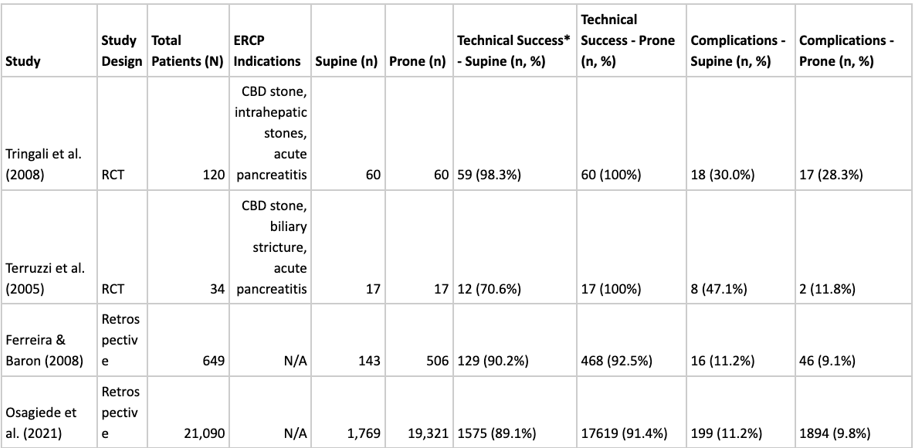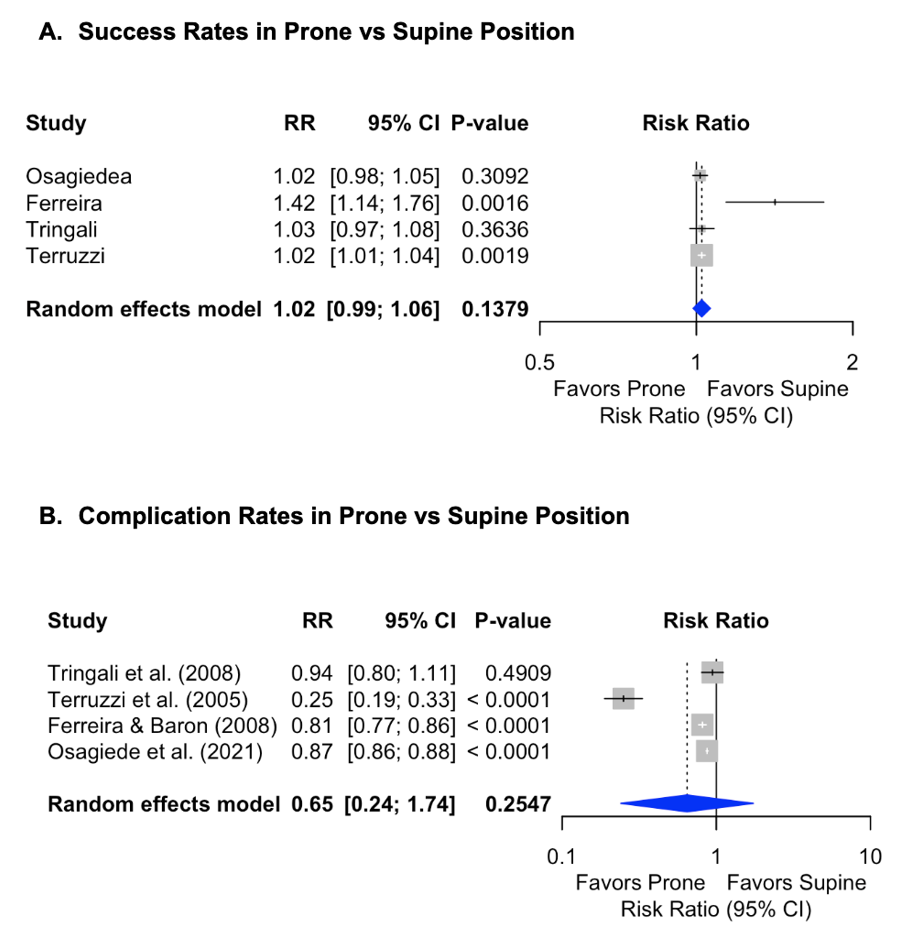Sunday Poster Session
Category: Biliary/Pancreas
P0006 - Comparison of ERCP Success Rates and Complications in Supine versus Prone Position for Biliary Cannulation: A Systematic Review and Meta-Analysis
Sunday, October 26, 2025
3:30 PM - 7:00 PM PDT
Location: Exhibit Hall

Essam Rashad, MBBCh
Parkview Medical Center
Fort Wayne, IN
Presenting Author(s)
Essam Rashad, MD1, Ibrahim Maghari, MD1, Pearl Aggarwal, MD2, Sara Saleh, MD3, Fazel Dinary, MD4
1Parkview Medical Center, Fort Wayne, IN; 2Cleveland Clinic, Cleveland, OH; 3Faculty of medicine,Hashemite University, Zarqa, Az Zarqa', Jordan; 4University Hospital, Cleveland, OH
Introduction: Endoscopic retrograde cholangiopancreatography (ERCP) is a critical procedure for managing biliary and pancreatic disorders. Previous reports showed that patient positioning is known to affect cannulation success rates and complications. While the prone position has been the traditional standard for ERCP due to its favorable orientation for endoscope maneuvering and bile duct access, supine positioning may be necessary in specific instances, for example, in the ICU setting. This meta-analysis aims to compare biliary cannulation success rates and complication rates between supine and prone positions during ERCP.
Methods: We conducted a comprehensive literature search using PubMed with the search terms: "(ERCP OR ''endoscopic retrograde cholangiopancreatography'') AND (prone [Title] OR supine [Title] OR position [Title] OR positioning [Title])" limited to the last 20 years. From 54 initial results, 11 relevant articles were screened. RCT and observational studies comparing ERCP performed in prone vs. supine positions were included. Primary outcomes were biliary cannulation success rate and complication rate. We used the DerSimonian-Laird (DL) random-effects model to conduct the meta-analyses in RStudio. The I-squared (I²) statistic was calculated to quantify the degree of heterogeneity between the studies.
Results: Our analysis included four studies with a total of 21,893 patients. The pooled analysis showed that prone positioning had a slightly higher success rate for biliary cannulation but was not statistically significant (RR: 1.02, 95% CI: 0.99-1.06, p=0.13). Complication rate favored prone positioning, however, was not statistically significant (RR: 0.65, 95% CI: 0.24-1.74, p=0.25). For the technical success analysis, the I² was 65%, p< 0.032. For the complications analysis, the I² was 96%, p< 0.001.
Discussion: Our meta-analysis highlights that while the prone position should remain the standard for ERCP, the supine position is a reasonable alternative for selected patients, with comparable complication rates and success in biliary cannulation. Circumstances may necessitate supine ERCP, and the decision to perform supine ERCP should be guided by individual patient factors and physician expertise. Further prospective studies are needed to identify subgroups that benefit most from each ERCP position.

Figure: Characteristics of included studies

Figure: Forest Plots (A) Success rates in prone vs supine position and (B) complication rates in prone vs supine position. RR: Relative risk. CI: Confidence interval.
Disclosures:
Essam Rashad indicated no relevant financial relationships.
Ibrahim Maghari indicated no relevant financial relationships.
Pearl Aggarwal indicated no relevant financial relationships.
Sara Saleh indicated no relevant financial relationships.
Fazel Dinary indicated no relevant financial relationships.
Essam Rashad, MD1, Ibrahim Maghari, MD1, Pearl Aggarwal, MD2, Sara Saleh, MD3, Fazel Dinary, MD4. P0006 - Comparison of ERCP Success Rates and Complications in Supine versus Prone Position for Biliary Cannulation: A Systematic Review and Meta-Analysis, ACG 2025 Annual Scientific Meeting Abstracts. Phoenix, AZ: American College of Gastroenterology.
1Parkview Medical Center, Fort Wayne, IN; 2Cleveland Clinic, Cleveland, OH; 3Faculty of medicine,Hashemite University, Zarqa, Az Zarqa', Jordan; 4University Hospital, Cleveland, OH
Introduction: Endoscopic retrograde cholangiopancreatography (ERCP) is a critical procedure for managing biliary and pancreatic disorders. Previous reports showed that patient positioning is known to affect cannulation success rates and complications. While the prone position has been the traditional standard for ERCP due to its favorable orientation for endoscope maneuvering and bile duct access, supine positioning may be necessary in specific instances, for example, in the ICU setting. This meta-analysis aims to compare biliary cannulation success rates and complication rates between supine and prone positions during ERCP.
Methods: We conducted a comprehensive literature search using PubMed with the search terms: "(ERCP OR ''endoscopic retrograde cholangiopancreatography'') AND (prone [Title] OR supine [Title] OR position [Title] OR positioning [Title])" limited to the last 20 years. From 54 initial results, 11 relevant articles were screened. RCT and observational studies comparing ERCP performed in prone vs. supine positions were included. Primary outcomes were biliary cannulation success rate and complication rate. We used the DerSimonian-Laird (DL) random-effects model to conduct the meta-analyses in RStudio. The I-squared (I²) statistic was calculated to quantify the degree of heterogeneity between the studies.
Results: Our analysis included four studies with a total of 21,893 patients. The pooled analysis showed that prone positioning had a slightly higher success rate for biliary cannulation but was not statistically significant (RR: 1.02, 95% CI: 0.99-1.06, p=0.13). Complication rate favored prone positioning, however, was not statistically significant (RR: 0.65, 95% CI: 0.24-1.74, p=0.25). For the technical success analysis, the I² was 65%, p< 0.032. For the complications analysis, the I² was 96%, p< 0.001.
Discussion: Our meta-analysis highlights that while the prone position should remain the standard for ERCP, the supine position is a reasonable alternative for selected patients, with comparable complication rates and success in biliary cannulation. Circumstances may necessitate supine ERCP, and the decision to perform supine ERCP should be guided by individual patient factors and physician expertise. Further prospective studies are needed to identify subgroups that benefit most from each ERCP position.

Figure: Characteristics of included studies

Figure: Forest Plots (A) Success rates in prone vs supine position and (B) complication rates in prone vs supine position. RR: Relative risk. CI: Confidence interval.
Disclosures:
Essam Rashad indicated no relevant financial relationships.
Ibrahim Maghari indicated no relevant financial relationships.
Pearl Aggarwal indicated no relevant financial relationships.
Sara Saleh indicated no relevant financial relationships.
Fazel Dinary indicated no relevant financial relationships.
Essam Rashad, MD1, Ibrahim Maghari, MD1, Pearl Aggarwal, MD2, Sara Saleh, MD3, Fazel Dinary, MD4. P0006 - Comparison of ERCP Success Rates and Complications in Supine versus Prone Position for Biliary Cannulation: A Systematic Review and Meta-Analysis, ACG 2025 Annual Scientific Meeting Abstracts. Phoenix, AZ: American College of Gastroenterology.
